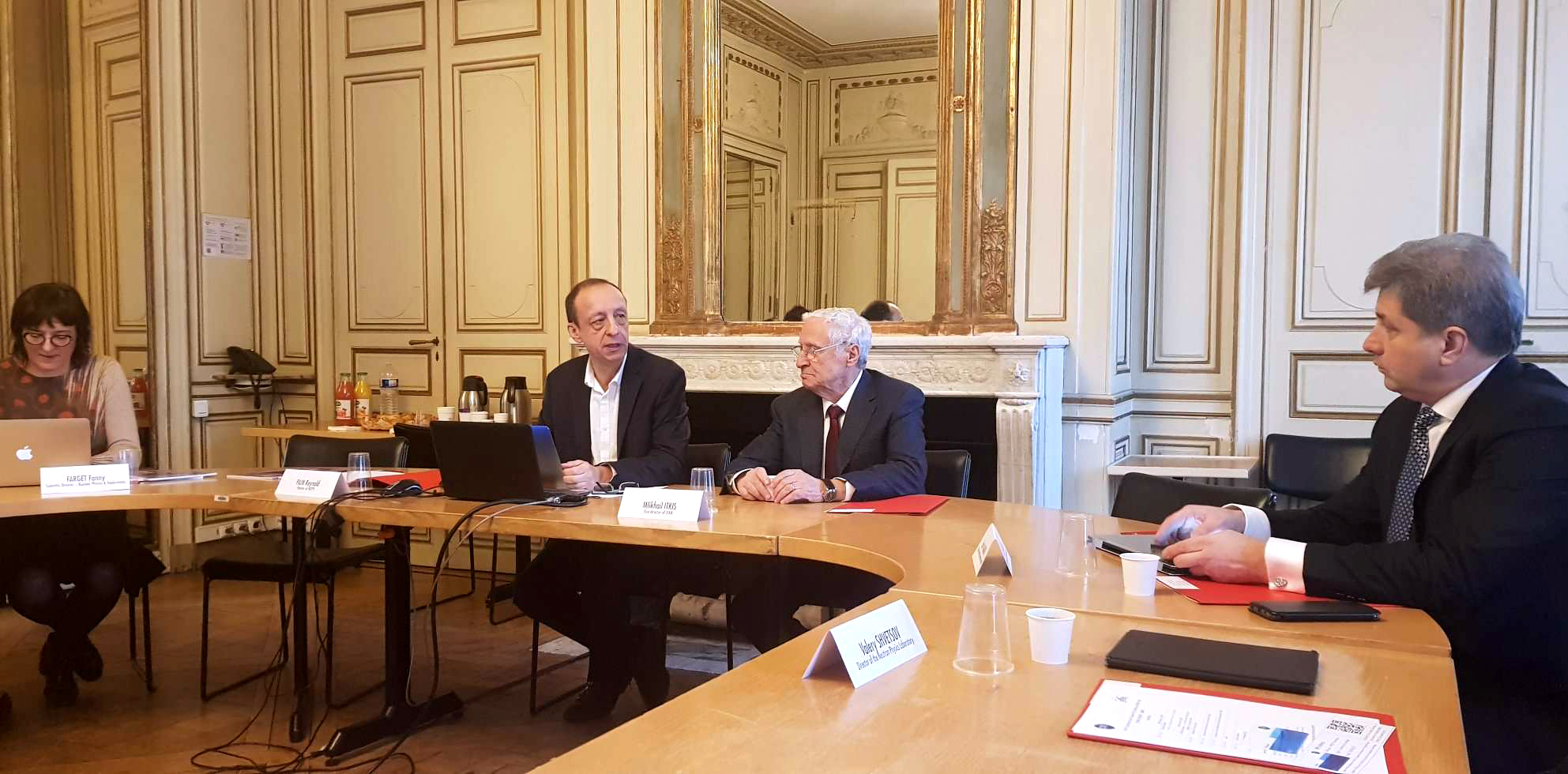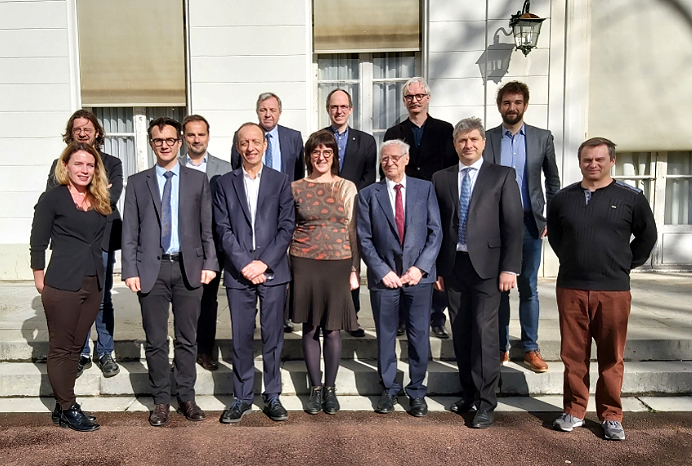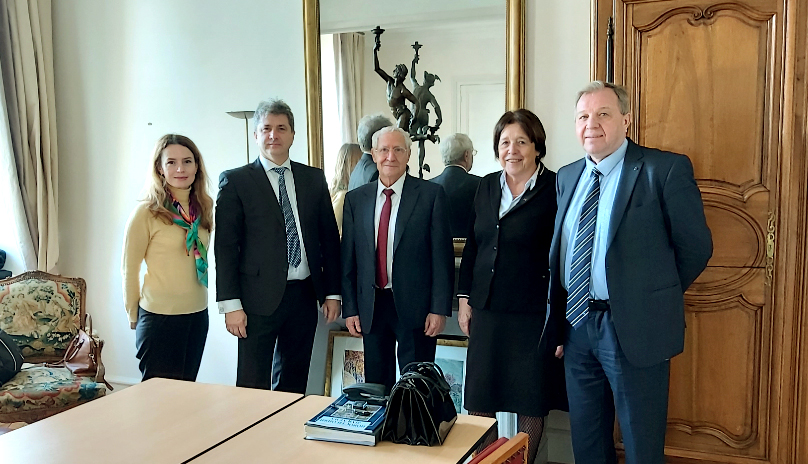Meetings in Paris
News, 12 February 2020
On 10 – 11 February 2020, the 30th meeting of the Joint Committee for Collaboration of the National Institute for Nuclear Physics and Particle Physics (IN2P3) and JINR took place in Paris, France. A JINR delegation headed by JINR Vice-Director M. G. Itkis arrived in Paris to take part in the event. The delegation was also represented by Head of the International Cooperation Department D. V. Kamanin and his Deputy A. A. Kotova, FLNP Director V. N. Shvetsov, DLNP Deputy Director D. V. Naumov.
The French party was represented by IN2P3 Director Reynald Pain, Scientific Directors Patrice Verdier, Fanny Farget, Jean-Luc Biarrotte, Volker Beckmann, as well as Head of the IN2P3 International Cooperation Office Thomas Palychata.
During the meeting of the Committee, the parties exchanged up-to-date information on current research projects of the institutes, presented the main achievements of the past year and plans for the future. The Committee participants heard reports on the current status and results of scientific projects in the framework of joint IN2P3-JINR research. The meeting was concluded with a traditional discussion of the planned scientific exchange in the frames of joint projects for the upcoming year and decision-making.
During the visit to Paris, the JINR delegation had a meeting in the French Academy of Sciences with a well-known international science organizer, Academician and Honorary Secretary of the French Academy of Sciences Catherine Bréchignac who visited JINR in November 2019. Participants of the meeting discussed the issues of expanding the JINR-France cooperation, in particular in the fields of applying physical methods to study cultural heritage objects. In this regard, the JINR delegation visited the Scientific and Research Laboratory of the Centre for Research and Restoration of the Museums of France (C2RMF) located at a depth of 15 metres under the Louvre. The guests got acquainted with the AGLAE accelerator for elementary analysis (Accélérateur Grand Louvre d’analyse élémentaire).
Professor M. G. Itkis gave his comments to the Institute’s media on the results of the Committee, “At the meeting, IN2P3 Director Reynald Pain presented the results of research on the fields interesting to us in France where our scientists take part in joint activities. It refers to neutron physics, including the Modane laboratory on SuperNEMO, as well as studies conducted by such centres as GANIL-SPIRAL 2, Orsay, Bordeaux and Strasbourg. On behalf of our party, I presented information about the latest results of the NICA project and the Superheavy Element Factory. French scientists come to FLNR, in general, to carry out research at the accelerator for studies on neutron spectroscopy of heavy and superheavy elements. And, of course, activities in the fields of neutrino physics, including the Baikal-GVD detector, were also covered. We also discussed future plans for these joint projects. Participants discussed both future plans for current joint projects and the issues of further cooperation development related to the associate membership of France at JINR. In the frames of this visit, we had a meeting with Ms Catherine Bréchignac in the French Academy of Sciences and our discussions were held in a friendly way. She took a very active part in promoting this idea and took up the duty to establish contacts with CNRS. It is the French National Centre for Scientific Research that unites state organizations of the country engaged in applied and fundamental studies. As for us, we develop a JINR regulatory document on associate membership. The high level of our cooperation and mutual interest of the parties in its development were highlighted. That is why there are no obstacles to the broader development of our interaction. Moreover, a new cooperation area in the fields of applied nuclear physics has recently emerged. It aims to study archaeological antiquities of cultural heritage using the neutron analysis methods the idea of which was proposed by Ms Bréchignac. In this regard, we visited the underground research laboratory in the Louvre equipped with modern facilities, including the AGLAE accelerator for the analysis and restoration of art objects. This unique facility allows determining the chemical composition of cultural heritage objects using non-invasive methods. We discussed prospects for our future cooperation in the field. The Louvre’s laboratory has been already actively cooperating with the Hermitage and the Russian Museum, we have been cooperating with the Moscow Kremlin. That is why we came up with the idea to launch joint projects, in particular, on the field of mobile laboratories allowing attracting experts, using equipment and technologies of various organizations to study immovable cultural heritage objects or items from museum collections. Summing up the results of the past Committee, we can say for sure that it was fruitful.”



